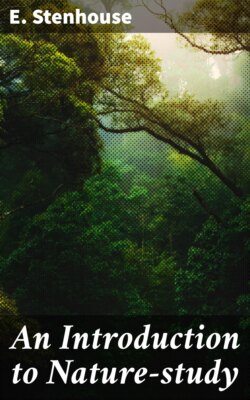Читать книгу An Introduction to Nature-study - E. Stenhouse - Страница 6
На сайте Литреса книга снята с продажи.
3. THE STRUCTURE OF GRAINS OF
MAIZE AND WHEAT.
Оглавление1. Preparation of the seeds.—Soak grains of maize (Indian corn) and wheat in water until they are soft. The grains of maize will need soaking for several days. Plant about a dozen of each in damp sawdust, and in the meantime examine others.
2. The maize grain.—A grain of maize is really a fruit, as a pea-pod is. A pea-pod contains several seeds; a maize fruit contains only one seed, which fills it. Notice the shape of the grain—flattened, rounded along one edge, and bluntly pointed at the opposite edge (Fig. 14). Notice a whitish patch on one of the flattened sides; a ridge (E) down the middle of this marks the position of the embryo. Cut through the grain lengthwise, so as to divide the embryo into two equal parts, and examine the cut surface (Fig. 15). Identify:
(a) The embryo, lying somewhat obliquely, and to one side. The radicle (rad.) is directed towards the pointed end of the grain, and the plumule (pl.) towards the rounded end.
(b) The endosperm (end): a mass of material outside the embryo, and forming at least half of the grain.
(c) The scutellum (scm): a plate lying between the endosperm and the embryo.
(d) The coats of the seed and fruit, surrounding the whole.
Draw. Add a drop of iodine solution to the cut surface of the half-grain. The endosperm turns blue. What does this indicate?
3. The wheat grain.—A grain of wheat is also a one-seeded fruit. Notice the groove along one side, and—on the opposite side near one end—the white patch marking the position of the embryo. At the other end is a tuft of very fine hairs. Cut the grain lengthwise, so as to divide the white patch into two equal parts, and make out the embryo, endosperm, and scutellum (Fig. 16). Draw. Test the endosperm with iodine solution. Does it contain starch?
Grains of maize and wheat.—A grain of maize or wheat is really a one-seeded fruit. In other words, the grain consists not only of the seed with its seed-coat, but also of the seed-case. In this respect it resembles the fruit of the sycamore (p. 8). When, however, a grain of maize or wheat is carefully examined, it is found to differ greatly from all the seeds hitherto mentioned. A maize grain is somewhat flattened, and rather pointed along one edge (Fig. 14). On one flat side, near the pointed end, may be seen a whitish patch, and, along the middle line of this, a ridge which marks the position of the embryo.
| Fig. 14.—Maize grain, showing the position of the embryo (E). (×4.) | Fig. 15.—A longitudinal section of a Maize grain, through the middle line of the embryo. end, endosperm; pl, plumule; rad, radicle; rt, origin of a root; scm, scutellum. (×4.) |
A wheat grain has a different shape. It is oval, with a deep groove running down one side. One end is clothed with a tuft of very fine hairs; near the other end, on the side opposite to the groove, is a white patch beneath which is the embryo.
These differences in shape are of small importance, for the two grains are really of very similar structure, as may be seen when they are cut through lengthwise with a sharp knife, in a direction which divides the embryo along its middle line. It is then plain that each grain consists of two principal parts: the embryo and the endosperm (Figs. 15 and 16). The embryo lies to one side and in the lower half of the seed. At its upper end the young stem and at its lower end the young root—each still enclosed in protecting sheaths—are easily seen. The greater part of the seed is quite outside the embryo; it is a mass of food called the endosperm, which has been stored up for the use of the young plant during its earliest stages of germination. This food mass at once turns blue when a drop of iodine solution is placed upon it, showing that it contains a considerable amount of starch. It is the endosperm which is made into flour when corn is ground.
Lying between the embryo and endosperm is a flat plate called the scutellum. Covering embryo, scutellum, and endosperm is the seed-coat proper, and outside that come the various layers of the fruit case.
Fig. 16.—Diagram of a longitudinal section
through the middle line of a wheat grain.
In the seeds previously examined, the embryo—consisting of plumule, radicle, and cotyledons—was seen to fill the seed-coat completely. In some cases the cotyledons were found to be more or less swollen with stored food-material. In the maize and wheat, however, the embryo forms only a comparatively small proportion of the seed, the bulk of which consists of stored food called endosperm. This is a difference of some importance. Still more important, however, is the fact that the two cotyledons, which were so conspicuous a feature of the other seeds, cannot apparently be seen at all in these seeds. Are there then no cotyledons in the seeds of the maize and wheat? If there are, how and when do they appear, and what is their number?
